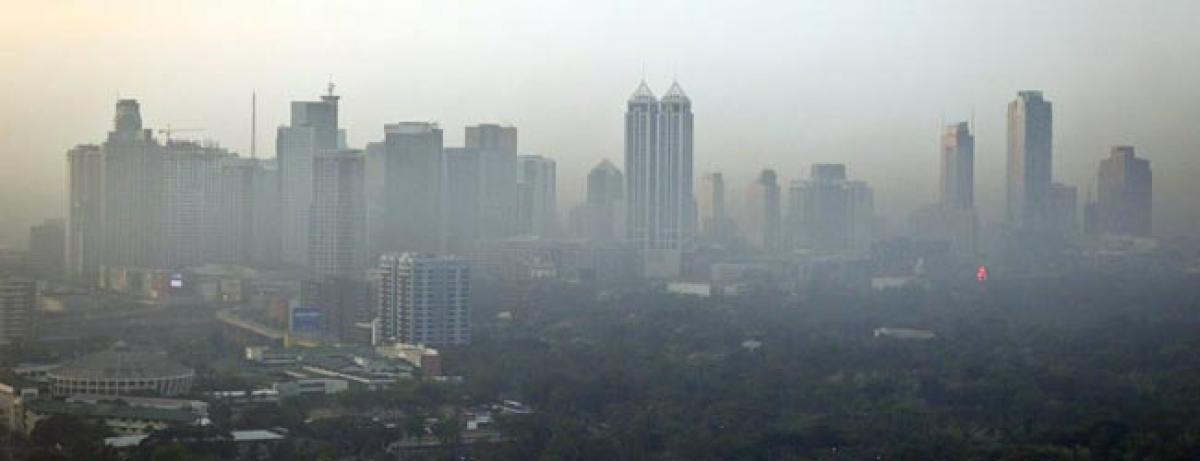Live
- 555th Prakash Purab celebrated with gaiety
- Good news for Atmakur farmers
- High-risk aortic valve replacement surgery performed successfully
- HMWSSB MD holds review meeting on OTS-2024 scheme
- Dhobi Ghat assessed for potential to host sports complex
- SCR bets on LHB train coaches for safety
- SVU felicitates best teachers
- Tata Group to market Araku coffee
- Union Min assures development of infra in tribal mandals
- KTR, Harish will turn political rivals soon: TPCC Chief
Just In

India can enhance its rice yields by 2.5 percent and wheat by 3.3 percent if emissions leading to generation of ground-level ozone could be mitigated, say scientists who have developed an ozone risk estimate database.
Kolkata: India can enhance its rice yields by 2.5 percent and wheat by 3.3 percent if emissions leading to generation of ground-level ozone could be mitigated, say scientists who have developed an ozone risk estimate database.
It could aid policymakers examine suitable mitigation strategies for crop protection against ozone pollution, they say.
"We found out that the total loss of wheat and rice from top 10 producing states in India is estimated to be 2.2 million tonnes (3.3 percent) and 2.05 million tonnes (2.5 percent), respectively," Gufran Beig, senior scientist at the Indian Institute of Tropical Meteorology, Pune, told IANS.
"So if we can control the emissions of ozone precursors (like volatile organic compounds and nitrogen oxides), then we would produce that much more," Beig added.
Ozone production requires sunlight and high ozone concentration coincides with the crop growing season.
It is generated in the troposphere (the lowest layers of the atmosphere associated with weather) when sunlight triggers complex reactions involving short-lived climate pollutants, volatile organic compounds (VOC), nitrogen oxides (NOx) and carbon monoxide that originate mainly through burning of fossil fuels.
Ozone pollution is known to impact human health, crops and ecosystem, and exposure to elevated levels of ground level ozone for longer duration can impact crops directly (yield or biomass). Also, ozone damage can occur to plants without any visible signs.
To shed light on the links between emissions and crop losses, the study on the ozone risk database was done by Sachin D. Ghude, C.K. Jena, D.M. Chate, and G. Beig of IITM; Rajesh Kumar of US National Center for Atmospheric Research; and SH Kulkarni of the Centre for Development of Advance Computing, Pune.
Published in the "Current Science" journal in April, it highlights that although VOC is one of the culprits, in comparison to NOx, its effects are only a "distant second."
"Our model suggests there is a relatively 93 percent decrease in ozone-induced crop yield losses if the NOx emissions are mitigated," said Jena.
To create software simulations and models, the team used most suitable spatial crop distribution and production data available for India and the latest emission inventories for 2005.
"These are long-term studies; so it is relevant. Since 2005, ozone has anyway shown an increasing trend and so the impact is likely to be more pronounced," said Beig.
The study also maps crop losses in million tonnes.
The rice-producing states that are vulnerable to relatively high ozone exposure are Punjab (0.85 million tonnes), Andhra Pradesh (0.33 million tonnes), Uttar Pradesh (0.25 million tonnes) and West Bengal (0.23 million tonnes).
Similarly, other wheat-producing states vulnerable to high ozone exposure are Uttar Pradesh (0.61 million tonnes), Madhya Pradesh (0.49 million tonnes), Rajasthan (0.23 million tonnes) and Maharashtra (0.22 million tonnes).
Beig iterates current ozone exposure impact assessment studies evaluated the global losses of major agricultural commodities amounting to 79 million to 121 million tonnes and costing $11 billion to 18 billion, and projected economic damage of about $12 billion to 35 billion by 2030.
A recent study by the World Meteorological Organization/United Nations Environment Programme (WMO/ UNEP) identified Asia to be vulnerable to ozone pollution.
"In India, the major problem in urban areas is due to particulate matter, but ozone pollution is a huge concern in rural pockets. The result of our analysis provides first-hand and important information to policymakers to propose or implement emission control of ozone precursors to ensure improved national food security," added Beig.

© 2024 Hyderabad Media House Limited/The Hans India. All rights reserved. Powered by hocalwire.com







